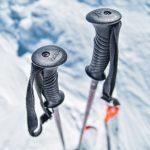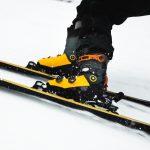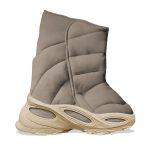Ski Boots Size Chart – Measurements And Fitting
Do you experience fatigue, cramping, or your feet hurting during and after skiing? It is either your ski boots are too large or small. To avoid these challenges, one has to follow appropriate ski boot guidelines to choose fitting ski boots. Our primary purpose is to ensure you are conversant with the ski boots size chart with our ski boot size guide.
For the last few years, the ski industry has made a significant improvement to make ski boots more comfortable, although it is still vital to pick fitting ski boots.
Pieces of equipment used by skiers are boots, Socks, Gloves, poles, Helmets, skis, and binding.

Ski Boot Size Chart
| Men (US) | Women (US) | Kids (US) | Mondo Point (cm and inches) | Euro | UK |
| – | – | 8.0 (Kids) | 14 – 14.5 cm 5.51181 – 5.708661 inches | – | – |
| – | – | 8.5 (Kids) | 14.5 – 15 cm 5.708661 – 5.90551 inches | – | – |
| – | – | 9.0 (Kids) | 15 – 15.5 cm 5.90551 – 6.102362 inches | – | – |
| – | – | 9.5 (Kids) | 15.5 – 16 cm 6.102362 – 6.29921 inches | – | – |
| – | – | 10.0 (Kids) | 16 – 16.5 cm 6.29921 – 6.496063 inches | – | – |
| – | – | 10.5 (Kids) | 16.5 – 17 cm 6.496063 – 6.69291 inches | – | – |
| – | – | 11.0 (Kids) | 17 – 17.5 cm 6.69291 – 6.889764 inches | – | – |
| – | – | 11.5 (Kids) | 17.5 – 18 cm 6.889764 – 7.08661 inches | – | – |
| – | – | 12.0 (Kids) | 18 – 18.5 cm 7.08661 – 7.283465 inches | – | – |
| – | – | 12.5 (Kids) | 18.5 – 19 cm 7.283465 – 7.48031 inches | – | – |
| 1.0 (kids) | – | 13.0 (Kids) | 19 – 19.5 cm 7.48031 – 7.677165 inches | – | – |
| 1.5 (kids) | – | 13.5 (Kids) | 19.5 – 20 cm 7.677165 – 7.87402 inches | – | – |
| 2.0 (kids) | – | – | 20 – 20.5 cm 7.87402 – 8.070866 inches | – | – |
| 2.5 (kids) | – | – | 20.5 – 21 cm 8.070866 – 8.26772 inches | – | – |
| 3.0 (Men) | 4.0 (Women) | 3.0 (Kids) | 21 – 21.5 cm 8.26772 – 8.464567 inches | – | – |
| 3.5 (Men) | 4.5 (Women) | 3.5 (Kids) | 21.5 – 22 cm 8.464567 – 8.66142 inches | – | – |
| 4.0 (Men) | 5.0 (Women) | 4.0 (Kids) | 22 – 22.5 cm 8.66142 – 8.858268 inches | 35 | 3 |
| 4.5 (Men) | 5.5 (Women) | 4.5 (Kids) | 22.5 – 23 cm 8.858268 – 9.05512 inches | 35.5 | 3.5 |
| 5 (Men) | 6.0 (Women) | 5.0 (Kids) | 23 – 23.5 cm 9.05512 – 9.251969 inches | 36 | 4 |
| 5.5 (Men) | 6.5 (Women) | 5.5 (Kids) | 23.5 – 24 cm 9.251969 – 9.44882 inches | 36.5 | 4.5 |
| 6.0 (Men) | 7.0 (Women) | 6.0 (Kids) | 24 – 24.5 cm 9.44882 – 9.645669 inches | 37 | 5 |
| 6.5 (Men) | 7.5 (Women) | 6.5 (Kids) | 24.5 – 25 cm 9.645669 – 9.84252 inches | 37.5 | 5.5 |
| 7.0 (Men) | 8.0 (Women) | 7.0 (Kids) | 25 – 25.5 cm 9.84252 – 10.03937 inches | 38 | 6 |
| 7.5 (Men) | 8.5 (Women) | 7.5 (Kids) | 25.5 – 26 cm 10.03937 – 10.2362 inches | 38.5 | 6.5 |
| 8.0 (Men) | 9.0 (Women) | 8.0 (Kids) | 26 – 26.5 cm 10.2362 – 10.43307 inches | 39 | 7 |
| 8.5 (Men) | 9.5 (Women) | 8.5 (Kids) | 26.5 – 27 cm 10.43307 – 10.6299 inches | 39.5 | 7.5 |
| 9.0 (Men) | 10.0 (Women) | 9.0 (Kids) | 27 – 27.5 cm 10.6299 – 10.82677 inches | 40 | 8 |
| 9.5 (Men) | 10.5 (Women) | 9.5 (Kids) | 27.5 – 28 cm 10.82677 – 11.0236 inches | 40.5 | 8.5 |
| 10.0 (Men) | – | – | 28 – 28.5 cm 11.0236 – 11.22047 inches | 41 | 9 |
| 10.5 (Men) | – | – | 28.5 – 29 cm 11.22047 – 11.4173 inches | 41.5 | 9.5 |
| 11.0 (Men) | – | – | 29.5 – 30 cm 11.4173 – 11.811 inches | 42 | 10 |
| 11.5 (Men) | – | – | 30 – 30.5 cm 11.811 – 12.00787 inches | 42.5 | 10.5 |
| 12.0 (Men) | – | – | 30.5 – 31 cm 12.00787 – 12.2047 inches | 43 | 11 |
| 12.5 (Men) | – | – | 30.5 – 31 cm 12.00787 – 12.2047 inches | 43.5 | 11.5 |
| 13.0 (Men) | – | – | 31 – 31.5 cm 12.2047 – 12.40157 inches | 44 | 12 |
| 13.5 (Men) | – | – | 31 – 31.5 cm 12.2047 – 12.40157 inches | 44.5 | 12.5 |
| 14.0 (Men) | – | – | 32.0 – 32.5 cm 12.5984 – 12.79528 inches | 45 | 13 |
| 14.5 (Men) | – | – | 32.0 – 32.5 cm 12.5984 – 12.79528 inches | 45.5 | 13.5 |
| 15.0 (Men) | – | – | 33.0 – 33.5 cm 12.9921 – 13.18898 inches | 46 | 14 |
| 15.5 (Men) | – | – | 33.0 – 33.5 cm 12.9921 – 13.18898 inches | 46.5 | 14.5 |

Ski Boot Sizing: Mondo Point Sizing
Mondo point sizing is ski boot sizing in centimeters. The ski boots’ liners and shells are produced in half to the whole size range, for example, 33.0 – 33.5 cm. The boot’s liner consists of an insole and a stock footbed.
However, the stock’s insoles do not provide arch support. This prompted the boot manufacturers to replace it with either custom footbeds or aftermarket footbeds.
Nowadays, the ski boot size ranges are either whole or half sizes. Due to the adoption of the aftermarket preformed/custom insole and footbeds producing whole and half sizes are not that critical anymore.
How do I determine the ideal ski boot flex?
Flex is the boot pressure required to bend the front of the ski boot. “The better the skier, the stiffer the ski boots” Stiff boots are recommended for advanced and expert skiers. Stiff boots require more technique and power to control; hence not recommended for beginners.
An athletic skier’s weight is used for determining the boot’s flex. Under normal circumstances, one can add 10-30 pounds to get the flex’s ideal weight ski size range. The weight range varies
depending on whether the skier is an average, aggressive, advanced, or expert skier. To avoid stiffer flex circumstances, one can adopt the ski weight chart below for correct flex.
N/B: There is a misconception that a skier’s height can be used to determine their ski boot size, which is technically wrong. While skiing, it is our weight that is imposed on the boots and not our height. More so, two different people of the same height can have different weights.
| Skier’s weight (lbs) | Skier’s weight (kgs) | Boot flex |
| 50 – 85 | 23-36 | 65 |
| 85 – 100 | 36-45 | 70 |
| 100 – 125 | 45-54 | 90 |
| 125 – 155 | 54-68 | 110 |
| 130 – 155 | 60-73 | 120 |
| ≥ 155 | 68+ | 130-140 |
How do I determine my ski boot size?
The ski boot manufacturers craft the boot design based on the Mondo point size scale. Determining your ski boot size is not complicated as the Mondo point size scale is in centimeters.
The foot measurements, both the foot length and width, determine one’s ski boot sizing. More so, the foot shape also influences the boot size. The foot shape is measured on the perspective of wide feet, narrow feet, and average feet.
Do you want to determine your ski boot size? Get your pal to trace your feet on a piece of paper or cardboard. Measure your feet from the heel to the toes using a tape measure. These foot measurements can be used to ascertain what ski boot size fits you correctly.
Measure your foot in centimeters. If your tape measure is calibrated in inches, convert the foot measurements in centimeters by multiplying the inches by 2.54 centimeters. Drop any fractions as your measurements should be a whole or .5 number. Ski boots size is not the same as your shoe sizing. To ensure the ski boots have a proper performance, they are either full or half size smaller than your shoe size measurements.
Does feet width determine the ski boot size?
The ‘last width” is the distance between the edge of the sheet of paper and the foot’s widest point. The boot manufacturers use the last width to design boots according to different feet width. To learn all about the importance of width in feet measurement, check the specialist post
- Narrow feet: 97 – 100 mm boot size
- Medium feet: 100 – 102 mm boot size
- Wide feet: ≥ 102mm
Ski Socks impact on Ski boots sizing
Like ski boots, ski socks are crucial gear in providing comfort during skiing and are essential to sizing ski socks properly. Like the ski layers, ski socks offer warmth. They are supposed to fit snugly and not bulky. Wearing the correct size socks is detrimental.
The boot manufacturers provide ski socks ranging from large, medium, and small with fewer extra larges and smalls. The size of the socks always correlates with your shoe size, which will determine your ski boot size.
It is recommended you pick thinner ski socks as they are light and not bulky hence their level of performance is high. If you are experiencing cold, well-fitting thicker socks will be suitable for you. A pair of socks that fits appropriately can make your skiing experience by keeping you warm and comfortable.
Have difficulties determining the type of skier you are?
It is best to understand which type of skier you are before having that memorable skiing experience. Knowing the type of skier you are, influences your skiing style and preferred terrain. It is important to note that your skiing ability determines the ski boot size.
1. Beginner
This is the level for the people new to the skiing experience who are still learning the basic skiing controls. Either softer flex boots or medium flex boots are recommended for beginner and intermediate skiers as they are comfortable mastering the mechanics of skiing sports. If you are in this category, it is advisable to purchase men/women’s intermediate/beginner alpine ski boots.
2. Intermediate skier
They have little experience and have mastered primary ski control, although they are still cautious. They ski at moderate speeds, and when at the challenging run, they become attentive. The intermediate skiers are required to use the medium flex boots that give them complete control.
3. Advanced intermediate skier
This is a seasoned skier with better basic technique, is capable of skiing freestyle terrain, off-trail terrain, and has developed strong technical and carving skills. They are comfortable skiing in snow or optimal snow conditions at moderate speeds.
4. Advanced skier
They can maintain technical solid skiing capabilities on terrains that are advanced in optimal snow conditions. They ski at high speeds and aggressively.
5. Expert skier
These skiers can ski at any terrain regardless of the snow conditions and at the highest speeds. They like skiing aggressively while maintaining their techniques.
In the expert/advanced levels, one should be looking for a precise ski fit boot, ranging from stiff flex to stiffer flex. The expert/advanced skiers work with their boot fitter to reduce the boots’ foot length and foot volume while still maintaining their comfort. The expert and pipe skiers prefer a softer, roomier flex in their ski boots.
With the help of specialized boot fitters, the skiers can choose from adult ski boots, alpine boots, to adjustable ski boots depending on the boot’s stiffness and flex.
Need help selecting your skiing style?
1. Cautious skier
These skiers ski in a reserved and controlled environment. They want to be in complete control of their skiing, and they prefer to ski at slow speeds but are not limited to beginner levels.
2. Average skier
They ski between moderate and high speeds. They are known to dial down their speeds when they find themselves out of their comfort zone. The average skier is a representation of the advanced, intermediate, and beginner skiers.
3. Aggressive skier
Represents the expert and advanced skiers who can ski out of their comfort zones.
Do the ski boot angles affect your skiing performance?
Are you finding it difficult to balance while skiing? It is probably you not having the right forward lean or ramp angle. Mostly it is the ramp angle that influences the level of performance of your ski boots.
The ramp angle is the angle subtended by your feet and boot board when standing on top of the boot board. On the other hand, the forward lean is the angle you form when posturing for a skiing position.
The primary purpose of these angles is to keep the skier’s balance between performances. If, while skiing, you find yourself out of balance, you are yet to achieve neither the forward lean nor the ramp angle.
The forward lean and the ramp angle are influenced by the fore-aft balance, ability to steer ski and tip, flexion-extension range, calf and leg shape, delta angle [bindings effects], external ramp angle [ angle of the boot sole], and the internal ramp angle [heel angle]. If you want to improve your level of performance, optimize the fore-aft boot setup.
Factors that influence the choice of your ski boots
Do you want to pick the right ski boot the first time? Then you will have to find a qualified boot fitter who will help you choose the best fit while considering the following factors:
- What is your skiing level?
If you are skiing for fun, especially at the beginner’s level, I recommend using the above Mondo point scale chart to pick your boot size. If you are either an aggressive or competitive skier, skiing under challenging terrains, then you will have to push the limits of your ski boots’ flexibility, stiffness, and fit.
- How much control do you need?
If you need more skiing control, then you need tighter ski boots with the correct flex. This is always determined by the space between the back of your ski boots and the heel. Work with a boot fitter to pick the boots with an optimized tightness without struggling.
- Foot shape and size?
Your foot shape and size determine your Mondo point length. A specialized boot fitter can help you fill the loose spaces in the boot shell to loosen the tight spaces and mold your size.
- Your footbed shape
You need custom boot fitting to optimize your forward lean. Your boot fitter can explain and show you how to benefit from custom insoles and footbeds.
- What is your last width?
With the help of your boot fitter, you can determine your last width. As stated above, various boots brands suit different individuals’ last widths. You are either a wide foot, average foot, or narrow foot. Use the above table to pick the best-fitting pair of boots according to your last width.
- Your skiing aggression and weight
When it comes to the stiffness of the boot, you have to consider your skiing aggression and weight. The more aggressive and heavier you are, the stiffer your boots should be.
| Level of aggressiveness | Weight (Kg and Lbs) |
| Male: Casual | 80 – 110 Kg 176.37 – 242.508 Lbs |
| : Aggressive | + 120 Kg + 264.555 Lbs |
| Female: Casual | 60 – 80 Kg 132.277 – 176.37 Lbs |
| : Aggressive | + 80 Kg + 176.37 Lbs |
- What kind of skiing will you do?
Chat with a qualified boot fitter on the specifications of the boots you need for the type of skiing you will do? Not all boot brands are suitable for classic country skiing, backcountry, piste, and racing. Only specific brands are ideal for these types of skiing.
Fitting Ski Boots
The ski boots should fit correctly without causing painful pressure points and cutting off blood circulation. After buckling your ski boots, you should feel a slight pressure on your longest toe. More so, if your leg is in an upright position after buckling, it is assumed the ski boot is of the right fit, and it will fit after a while.
Do your ski boots feel short? With the boot buckles unbuckled, flex the boot hard. This will help create more space at the front of the ski boot. When flexing the boot, you should feel slight or no pressure at all. Confirm the source of pressure, is it fit for the liner? Take it out of the boot shell and confirm with your boot fitter.
It is advisable to wear thin ski socks when fitting your bootstraps. Thicker socks provide warmth during skiing. However, the boots industry provides foams and plastic shells for insulation. More so, thick socks reduce the response and control during skiing. You want to be the best skier; I suggest you start wearing the thinnest ski socks available.
Ski Boots size explained
Conclusion
Most skiers ranging from beginners, intermediates, and even the experts at one point have been faced with the challenge of picking a fitting ski boot. However, with the above standard ski boot size chart, it has become easy. More so, apart from the ski boot size guide, one can access information on how to determine your ski boot size and the feet width measurements.
The most fundamental part of having the most memorable skiing experience is a fitting ski boot. Remember, it always takes one bad day to learn how exciting skiing can be! It is advisable to choose fit ski boots according to your skiing experience and foot shape.
If you have any questions on ski boot sizing, don’t hesitate to contact us in the comments sections!
Picture in this post by Ethan Walsweer on Unsplash
Related Ski and snow Size charts
- Ski pole size advice with easy to use size charts
- Bogner Size Chart: Fire+Ice Sizes for men, women & kids
- Ski helmet size chart
- Ski Boots Size Chart – Measurements And Fitting
- Snowboard Size Chart – Guide To Choosing A Snowboard
- Skiing Gloves Size Guide – Determine Your Glove Size
- Yeezy NSTLD Boot Size Chart and Fitting








